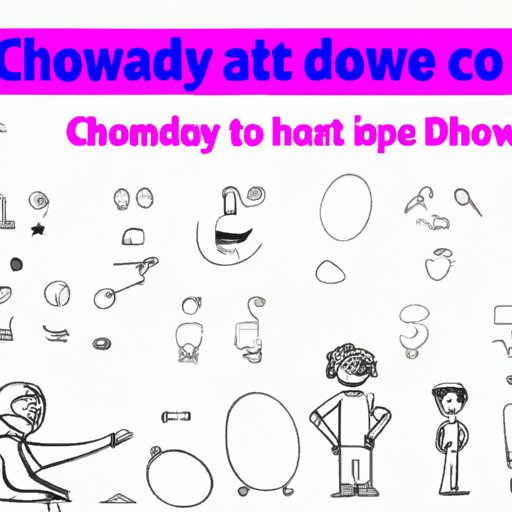
I. Introduction
Cartooning is a fun and creative way of expressing yourself and sharing your ideas with others. Whether you are a beginner or an experienced artist, drawing cartoons can bring you joy and satisfaction. This article will provide you with step-by-step instructions, tips, and tricks on how to draw cartoons that will help you create your own unique character.
II. Basic shapes and guidelines
One of the fundamental aspects of cartooning is learning how to use basic shapes and guidelines as a foundation for your character design. These shapes help you to map out the proportions and overall structure of your character before you add details.
You can start by drawing simple shapes such as a circle, oval, triangle, and rectangle. For instance, a circle can be used to create a character’s head, while an oval can be used for the body. The triangle can be used to shape arms and legs, and a rectangle can be used for the character’s torso.
To use these shapes as guidelines, you can start by placing a circle for the head and a neck line. Then, add a body shape and some lines to indicate the limbs. These guidelines will help you create a proportional character.
III. Step-by-step tutorial
Now, let’s get started on drawing a specific cartoon character. We will use the basic shapes and guidelines as a foundation for our character. For this tutorial, let’s draw a cartoon cat character.
Step 1: Draw a circle for the cat’s head, add two smaller circles for the ears, and draw a line for the center of the face.
Step 2: Add two curved lines for the body and another curved line for the tail. Use triangles for the front legs and ovals for the hind legs.
Step 3: Draw circles for the eyes and pupils. Add a triangle for the nose and a curved line for the mouth.
Step 4: Add details to the ears by drawing a curved line for the inside and triangles for the ears. Draw stripes on the body and tail. Add paws on the feet by drawing ovals for the front paws and triangles for the hind paws. You can also add whiskers and fur details to make the character more alive.
IV. Detailed technique
After completing the basic steps, you can develop your character by paying attention to details. One of the most important things is adding depth and shading to give your cartoon character a 3D feel.
For instance, you can add shading to the eyes, nose, and mouth to create a sense of dimension. By adding darker shades to the bottom, you can create a sense of shadow. You can also add highlights to the top, giving the character’s features depth. Additionally, experimenting with different textures and patterns can help add a unique flair to your character.
V. Tips and Tricks
Here are some professional tips and tricks to help you take your cartooning skills to the next level:
- Use overlapping shapes to create layers and make your character more dynamic.
- Use color to convey emotions. For instance, a red character can indicate anger, while a blue character can indicate sadness.
- Experiment with scale to create a sense of depth and playfulness.
- Try creating a style that is unique to your character. For instance, you can draw your character with one big eye or a unique hairstyle.
VI. Using technology
Cartooning has evolved with technology to offer infinite possibilities. Digital tools such as Adobe Illustrator can help you create more complex characters, perfect your lines, and enhance your shading and coloring. Using a graphics tablet or pen can also make drawing more natural and comfortable.
You can use Adobe Illustrator to create vector graphics, which is essential in character design. You can experiment with your character’s features and customize the shapes and colors. The software also allows you to make changes to your characters quickly.
VII. Cartooning for kids
Cartooning is a fantastic way to engage children’s creativity. Cartooning is easy to learn because it involves using basic shapes and colors. To get started, you can teach your young ones how to draw stick figures or simple shapes. You can also break down characters into easy-to-manage steps, like in our tutorial, to build their confidence.
VIII. History of cartooning
Cartooning has a rich history dating back to ancient times. Many famous cartoonists have contributed to its evolution, such as Walt Disney, Matt Groening, and Charles Schulz. Learning from their styles can help you develop your own. Studying the history of cartooning can provide you with inspiration and new ideas for your work.
IX. Conclusion
Cartooning is a fun and rewarding art form that anyone can learn. By using basic shapes and guidelines, you can create an endless amount of characters. By paying attention to details and using shading and color, you can bring those characters to life. Cartooning can be a great way to express yourself and connect with others. We encourage you to keep practicing and learning more about this exciting art form.





